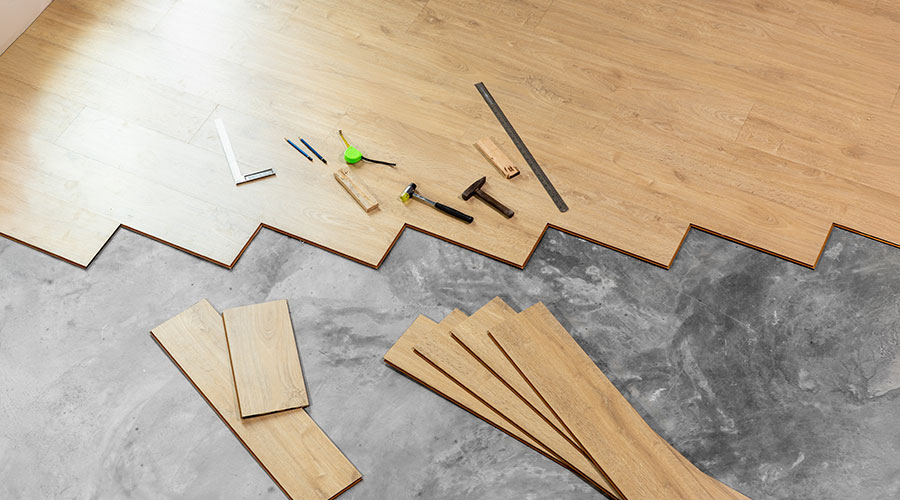Cost-Effective Flooring Installation
Cutting corners on contractor selection can backfire
You’ve spent hours determining the type and style of flooring that will work best for your facility. At this point, you might think that you’ve
finished the work needed to ensure a long-lasting, high-performing, attractive floor.
Think again. Just as important as the flooring itself is the contractor hired to install it. “Facilities executives understandably spend quite a bit of time determining that they have the best flooring product at the best price,” says Lori Dowling, president and chief executive officer of StarNet Commercial Flooring Cooperative. “However, they often don’t do that for the installation, which can be fraught with problems, such as excessive moisture and poorly completed seams.”
It’s easy to underestimate the scope of work involved in a commercial flooring installation project and to assume anyone can handle the work. That can lead some facilities executives to think that buying flooring products directly from the mill and then hiring their own flooring contractor will result in a quality job at a lower price.
That’s usually not the case. For starters, many commercial contractors, because they purchase large quantities of carpet each year, are able to obtain a better price than even a large company can on its own.
In addition, many may increase their costs to account for the extra risk they take on for installing a product they didn’t purchase. The reason: Because they weren’t involved in the selection of the flooring material, the contractor can’t be absolutely sure the product is suited for the application.
Although a commercial flooring project may appear to be a relatively straightforward undertaking, that’s usually not the case. “It’s a major construction project,” says Bill Bohrer, president of Wall 2 Wall Floorcoverings, Ketchum, Idaho. “There is a lot of planning that goes into the project and technical pitfalls that you have to avoid.” For instance, if the contractor doesn’t properly heat-weld two pieces of flooring together, the seams can end up cracking and coming apart, Bohrer says.
A competent contractor can provide insight into the type of floor covering that will work best in a specific setting. “There are huge differences in fibers, dye systems, vacuum systems and installation techniques,” says Richard Wolland, executive vice president and partner with Lanes Flooring + Interiors in New York City. For instance, his firm replaced cut-loop carpet that had been installed in a retail location. “The original carpet looked great going in, but two months later, it was ripped out,” he says. The carpet simply wasn’t holding up under the traffic.
Many designers and architects are driven by aesthetics, Wolland says. While they can offer great insight into the look of the flooring, architects and designers often aren’t as knowledgeable about the type that will perform best in a given environment.
“A highly polished terrazzo, ceramic or marble floor in a lobby entrance looks beautiful,” says Dave Stafford, executive vice president with Commercial Carpets of America, Alexandria, Va. However, “without a sophisticated mat system to capture water and dirt from the outside, there is a great potential for slip-and-fall accidents.”
Experienced flooring contractors agree that the most common problem in flooring projects is the presence of excessive moisture in the sub-floor. This usually is a result of compressed construction schedules, which leaves little time for concrete sub-floors to dry properly.
Moisture can cause problems in several ways. If hard-surface flooring is installed over a sub-floor with a high moisture content, the water won’t be able to escape through the floor. That can create a breeding ground for mold. Excessive moisture in the sub-floor also can keep the flooring adhesive from gripping adequately.
High moisture levels aren’t the only reason that flooring adhesives fail. Bill Imhoff, president and chief executive officer with InterTech Flooring, Austin, Texas, is working on a project in which the curing compound used in the cement sub-floor is preventing the flooring adhesive from properly holding. As a result, his crew likely will need to “bead blast” the cement. They’ll use a machine that shoots steel pellets into the cement to break up the surface area, allowing for a stronger bond between the floor and sub-floor.
Another potential problem occurs when the sub-floor has imperfections, such as areas that are patchy or uneven. With linoleum and some other hard-surface floors, these can be seen through to the floor, says Wolland. An experienced flooring installer will check for such flaws before proceeding with a job.
Drilling Down to Details
To increase the likelihood that a job will go smoothly, facilities executives must be clear and detailed when writing up their job specifications.
For instance, just stating that the contractor should test for moisture isn’t enough. The contract also should spell out what sorts of moisture tests will be used, how many times they’ll be performed, and what areas of the building will be tested. The contract also should state what moisture levels will be considered acceptable before the installation is allowed to proceed.
While it’s generally not necessary for facilities executives to oversee every aspect of a floor covering installation project, they should be available to address questions or problems as they come up, says Stafford.
Finally, facilities executives should allow enough time for the flooring project to proceed at a reasonable pace. Unfortunately, that doesn’t always occur. “Flooring is usually at the end of a long project, and the timeline for installation tends to be compressed,” says Stafford.
Rushing the process can backfire. For instance, if the schedule must be accelerated, the contractor may use multiple crews or work overtime. Both of these increase the need for coordination and supervision, and almost always mean a higher cost.
Most importantly, hiring qualified, experienced and competent flooring installers will help ensure that a floor covering looks good and performs well. As a starting point, look for a contractor with a history of experience and satisfied clients in a specific market. Also look for a contractor that has received thorough training. InterTech Flooring offers a three-year, 4,000-hour apprenticeship program, says Imhoff. “We start with safety and also teach them how to cut, measure and install carpet and resilient flooring.”
Such a program helps apprentices learn the complexities inherent in big commercial jobs. As an example, InterTech is installing about 400,000 square feet of linoleum flooring in a health care facility. Because of the high number of jet-cut insets in the design, the installers need to weld about 170,000 lineal feet of seams. “That type of project requires a high level of understanding of the job,” Imhoff says.
A qualified contractor who stays up to date on flooring technology also is able to point out techniques that will make a job proceed more smoothly, Dowling says. For instance, new lift systems can hoist heavy shelving units — in libraries, for instance — so that the floor can be installed without having to remove all the items from the shelves.
What’s more, working with an experienced floor covering installer often costs no more than hiring a less-experienced one, says Imhoff. “The cost of installation doesn’t vary greatly.”
In fact, inexperienced or sloppy contractors can generate extra costs in several ways. They may order more flooring material than is necessary to make the project easier for themselves. For instance, a contractor may buy extra floor covering so it is easier to quickly match the pattern at the seams. In the end, of course, that boosts costs. The contractor may not adequately test the sub-floor for moisture, resulting in a floor covering that fails. Similarly, the contractor may not properly seam the floor covering, which also could cause it to fail. Or the contractor may fail to follow the manufacturer’s installation directions, says Stafford. In some cases, that can void the manufacturer’s warranty.
“Installation is a very small percent of the overall life cycle cost,” says Wolland. The cost of the flooring itself, plus the expense of maintaining it over the seven to eight years that most commercial floor coverings remain in place, will make up most of the overall cost of any flooring.
To increase the likelihood of a successful flooring project, consider both the flooring covering itself, and the company you hire to install it. “Find a contractor that you know is good, that you can rely on, and that has proven itself,” Bohrer says.
About Starnet
StarNet Commercial Flooring Cooperative is a member-owned-and-run cooperative of about 150 commercial flooring contractors in 250 markets across the nation. It was established in 1992 to provide a means of ensuring the professionalism of flooring contractors.
To join StarNet, a flooring contractor must meet several important standards, says Lori Dowling, StarNet president. For instance, each contractor must show a history of successful installations in its market area, as demonstrated through client testimonials.
StarNet members also must be financially stable, as the organization does a full credit check on applicants. That allows StarNet to determine whether the contractor is able to purchase products for customers.
In addition, members agree to attend StarNet’s annual meeting. “They share and benchmark best practices,” says Dowling.
In fact, a recent study by W.E. Imhoff & Company found that purchasing carpet direct from the mill and then using a third-party installer can add up to almost $9 to the cost per square yard of flooring.
|
Related Topics:










